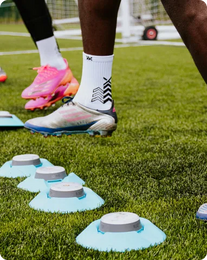Agility, speed, and endurance are the three keys to excelling in football. The players who dominate the pitch focus on workouts that enhance sprint performance and the ability to change direction instantly. While speed and agility are vital, maintaining peak performance for the full 90 minutes (endurance) is even more critical.
If you are wondering what is the best workout for a football player, look no further. In this comprehensive soccer workout routines guide, we highlight soccer training ideas and workouts for soccer players designed to fine-tune these essential components.
Soccer Workouts for Speed
Speed and reaction time are crucial skills for any football player. Whether on offense or defense, quick footwork is essential for gaining or shielding the ball. Top professional football players like Cristiano Ronaldo, Lionel Messi, and Kylian Mbappe are all remarkable sprinters.

You don’t need to reach Cristiano’s blistering speed of 24 mph from the 2018 FIFA World Cup, but as a striker, running at full speed while dribbling will keep defenders on high alert. Likewise, defenders need speed to catch up with offensive players and prevent them from breaking through.
Here are the best soccer conditioning workouts to enhance your speed:
Uphill Sprints
Speed hill training is highly recommended for soccer players looking to build speed. This type of training may seem simple in theory, but it's akin to sprinting while lifting weights. The gradient makes the sprint challenging, forcing you to push even harder.
When done correctly, this resisted exercise combines speed and strength training for soccer players, offering various benefits such as building stamina, increasing ankle strength, and boosting explosiveness. For coaches, these soccer team workouts can also promote mental toughness and goal-setting behavior among players.
How to do uphill sprints
- Begin at the starting point in a solid 2.0 stance.
- Explode out of the stance and sprint uphill at your top speed for 20-30 yards.
- Walk back down the hill and cool down for approximately 90 seconds before the next rep.
- Complete 4-8 repetitions, with 90-120 seconds of rest between each.
Sled Pushes
The sled push, also known as a prowler press, is essentially a sled loaded with weights. This exercise offers a comprehensive full-body strength and speed workout, making it ideal for challenging your physical fitness.
Sled pushes are incredibly versatile, can be customized for various training effects and are a great option for gym exercises for soccer players. When performed correctly, they rev up your metabolism and elevate your heart and lung activity without the muscle strain typically associated with weight lifting.
Proper sled pushes engage your lower and upper body muscles, including the chest, shoulders, abdominals, quads, glutes, and calves. This leads to improved sprint performance and overall athleticism.
How to push sleds for football speed
- If you're new to the sled, start with around 30-40% of your maximum load.
- Use a lower grip on the bars to mimic a natural sprinting position.
- Push the sled for 30-40 yards with 100% effort.
- Take a 2-minute rest before sprinting the sled back to the starting point.
- Repeat this sequence 8-10 times, ensuring adequate rest between each sprint.
Soccer Workout for Agility
While sprinting speed is vital for football players, soccer is a fast-paced game that demands sudden starts, quick turns, and instantaneous changes in direction—it's far from linear.
Agility in soccer means being able to change direction at speed without losing coordination, strength, balance, or control of the ball.
Attackers, in particular, need superior agility to outmaneuver defenders. Defenders, however, also require a blend of flexibility and strength to keep strikers at bay. For goalkeepers, agility is paramount; they must react instantly, diving and springing in all directions to save goals.

1-on-1 Change of Direction
This drill is among the best soccer drills with cones for developing a player's reaction time, footwork, and quick direction changes. It's simple yet highly effective, and it adds an element of fun, especially during warm-ups. Give it a try, and watch your agility improve!
How to set up and do it
- Arrange 2 parallel lines using five cones, with a 6-yard space between them.
- Leave a 4-yard gap between the first four cones in each line, and a 10-yard gap between the fourth and fifth cones.
- Divide the team into two groups. Each group stands behind the starting cones in a line. Assign one group as leaders and the other as followers.
- The first leader sprints forward when ready, with the first follower running immediately to stay close.
- The leader makes a sudden 180-degree turn at any of the three cones and heads back towards the starting line, then makes another turn to sprint to the finishing cone.
- The follower mirrors the leader's turns, staying as close as possible.
- After the second turn, both players sprint to the finish line, trying to outdo each other.
- The next pairs of players begin after the first players finish.
After finishing, the two players rejoin the line, switching roles so that the leader becomes the follower.
To keep these speed and agility workouts engaging, rotate players so each athlete has the opportunity to face all teammates.
In/Out Agility Ladder Drill
An agility ladder is an affordable tool that enhances your soccer training by challenging your agility, endurance, coordination, and cardiovascular fitness.
This foldable ladder can be rolled out and used almost anywhere—on the pitch, at the gym, or even in your bedroom. If you don't have an agility ladder, you can easily create one by drawing a ladder on the floor with tape.
How to do agility ladder in/out drill
- Roll out the ladder on a flat surface.
- Stand at one end with your feet hip-width apart.
- Hop forward into the first square.
- Push off immediately, spreading both feet outside the ladder.
- Hop into the next square with both feet, then push off again.
- Repeat these steps through the entire ladder.
The in/out drill is just one of many exercises you can do with an agility ladder. Check out this comprehensive guide on soccer speed and agility drills for more ways to utilize this versatile tool.
Leg Workouts for Soccer Players
So, how do you train strength for soccer? It may sound obvious, but you have to start with the legs. While soccer engages the entire body, the legs do most of the work. Most movements on the field require excellent lower body strength, including running with the ball, tackling, blocking opponents, and making passes or shots on goal.
Effectiveness in these actions depends heavily on lower body strength. The best soccer exercises focus on building strong legs, which will increase your explosive power, speed, endurance, and ability to perform various drills. Strengthening your legs is crucial for improving overall performance on the field.

Box Jumps
Box jump training is an excellent drill for soccer exercises at home, offering numerous benefits that contribute to becoming a healthy and physically fit football player.
Box jumps are among the best drills for beginners due to their simplicity and adaptability to different experience levels. This exercise strengthens your legs, promotes balance and posture, and helps develop a stronger core and powerful arms, making it an effective training tool for soccer players. You want to know how to train like a soccer player at home? Here’s the best place to start.
How to exercise for soccer using box jumps
- Place a box or set of boxes two feet in front of you at a challenging but manageable height.
- Stand with your feet shoulder-width apart in a half-squat position. Align your head with your spine and extend your arms to line up with your torso behind your glutes.
- To jump, use all the energy from your legs and hips to push up.
- Perform 4-5 sets of 6-8 repetitions each.
Jump Squats
Jump squats are another effective training exercise for soccer that requires no equipment. This high-intensity workout targets your leg muscles, glutes, and lower abs. When performed correctly, squat jumps also rank among the best soccer drills for kids, enhancing overall physical performance, balance, and mobility.
How to train for soccer using jump squats
- Start by standing straight with your feet shoulder-width apart.
- Place your hands by your side, roll back your shoulders, push your chest up, lift your chin, and look ahead.
- Bend your knees and push your hips back to assume a sitting position, ensuring your knees don’t go past your toes.
- Squat down with your palms together.
- Spring up from the squat position by throwing your hands down.
- Land gently and return to the squat position, bringing your palms together, pushing your hips back, and bending your knees just enough to keep them from overshooting your toes.
- Complete 3 sets per session with 15 reps each.
Soccer Workouts for Endurance
As a physically fit soccer player, you should be able to sprint, dodge, and jump as quickly in the final minutes of the match as you did at the start. If you want to know how do you build stamina like a soccer player, you will need to be able to target endurance exercises to build a strong system. Endurance workouts are intensive exercises designed to help you maintain peak performance until the final whistle.
These exercises offer several benefits, including faster recovery, enhanced focus, and improved decision-making. The intensity of these workouts also trains your heart to deliver oxygen to your muscles efficiently, keeping you fighting strong until the last second.

Burpee Pull-Ups
Burpee pull-ups are one of Ronaldo’s favorite conditioning drills for several reasons. These exercises target a wide range of muscle groups, including the upper body, core, and lower body. The combination of movements effectively elevates your heart rate quickly, providing a robust cardiovascular workout.
Each repetition strengthens your chest, abs, arms, quads, hamstrings, and glutes, among other muscle groups, enhancing overall strength and endurance.
How to do burpee pull-ups for soccer training
- Stand under a high bar with your feet shoulder-width apart.
- Bend down and place your hands on the floor a few inches in front of your toes, then quickly jump your legs back into a push-up position.
- Perform a push-up, and as you push up, lift your hips rapidly to transition into a squat position.
- From the squat, stand up and jump to grab the bar, performing an immediate pull-up.
- After completing the pull-up, return to the standing position and repeat.
- Aim for 5-10 push-ups and 5-10 pull-ups per set.
HIIT on treadmill
A treadmill is an excellent alternative when the weather disrupts your outdoor workout plans. High-Intensity Interval Training (HIIT) treadmill workouts are especially beneficial for building football-specific endurance.
These exercises elevate your heartbeat and push your fast-twitch muscle fibers to their limits. Regular and consistent HIIT workouts stimulate muscle growth to handle future physical demands effectively. HIIT treadmill workouts can be customized in various ways to suit your training needs.
How to do it
- Begin with a 5-10 minute warm-up by walking or jogging.
- Gradually increase the speed to reach 80-85% of your maximum heart rate, and run at this pace for 1 minute.
- Follow this with a 1-2 minute recovery period at a comfortable walking or jogging pace.
- Repeat the 1-minute sprint and 1-2 minute recovery cycle for 20-30 minutes.
- Conclude the workout by gradually slowing down and walking or jogging for 5 minutes to cool down.
Conclusion
If you find yourself wondering, ‘What exercises should soccer players do? ‘ Completing any of the drills mentioned would be optimal training for soccer players. Give it your all, and see how you progress!




















